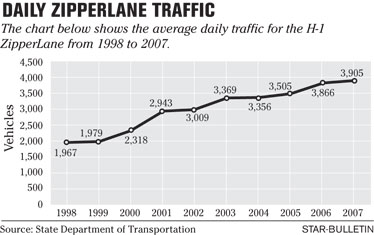CRAIG T. KOJIMA / CKOJIMA@STARBULLETIN.COM
State Transportation Director Brennon Morioka held up new signs yesterday giving rider minimums for Express (ZipperLane) and high occupancy vehicle lanes.
|
|
ZipperLane change starts today
Star-Bulletin staff
State transportation officials noticed fewer cars in the ZipperLane during the morning commute into town today, the day the requirement to use the lane went to three people instead of two.
It's a controversial move, but the state Transportation Department says it's necessary.
"Things are going smoothly and the drivers are definitely aware of the changes that were happening," state Department of Transportation spokes-woman Tammy Mori said.
Mori said the agency's ultimate goal of providing an incentive to carpool will not be reached overnight.
"But we definitely saw that incentive today, as cars in the ZipperLane were traveling quicker than usual," Mori said. "We believe that as more people decide to carpool, we should see an overall reduction in traffic across the board."
The change was made as the number of cars driving on the H-1 freeway-Nimitz Highway ZipperLane has steadily increased in the last 10 years, slowing down the commute time and diminishing the incentive for Oahu motorists to carpool, transportation officials said yesterday.
State Transportation Director Brennon Morioka said, "we see more cars using the ZipperLane, but we're actually moving a lot less people. By making this change, we hope that people will see the benefits of a shorter commute time."

The state opened the ZipperLane, which contra-flows eastbound traffic in the westbound H-1 freeway lanes and Nimitz Highway from Waikele to Iwilei, in 1998 with nearly 2,000 cars with the three-person minimum traveling on it annually.
The state lowered the minimum requirement to ride in the ZipperLane to two people in 2005, when more than 3,500 people traveled on it.
After 2005, Morioka said, more cars began clogging the ZipperLane. While there was an increase in use, it has not translated into shorter commute times. Morioka pointed out that motorists traveling between 5:30 and 6:30 a.m. on the ZipperLane actually spend about 20 minutes longer than cars traveling on the noncontra-flowed freeway lanes.
The state announced the recent change two weeks ago to some objection by community members, especially West Oahu residents most affected by the stricter requirements.
Other agencies do not expect the change to affect their operations as much. The Honolulu Police Department will have officers enforcing the new rule. Jon Nouchi, manager of TheBus' service department, said he expects increases in bus ridership.

